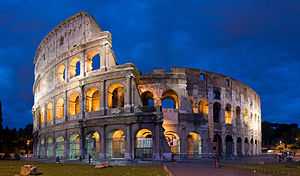Amphitheatre

An amphitheatre or amphitheater /ˈæmfɨˌθiːətər/[1][2] is an open-air venue used for entertainment, performances, and sports. The term derives from the ancient Greek ἀμφιθέατρον (amphitheatron),[3] from ἀμφί (amphi), meaning "on both sides" or "around"[4] and θέατρον (théātron), meaning "place for viewing".[5][6]
Ancient Roman amphitheatres were oval or circular in plan, with seating tiers that surrounded the central performance area, like a modern open-air stadium. In contrast both ancient Greek and ancient Roman theatres were built in a semicircle, with tiered seating rising on one side of the performance area. Modern usage for "amphitheater" is lax, and does not always respect the ancient usage. As a result the word can be found describing theatre-style stages with the audience only on one side, theatres in the round, and stadiums. Natural formations shaped like man-made theatres are sometimes known as natural amphitheatres. The three largest Roman amphitheatres (in the original sense) in the world in order of size are the Colosseum, the Amphitheatre Campania and the Amphitheatre of El Djem.
Roman amphitheatres

Ancient Roman amphitheatres were major public venues, circular or oval in shape, and used for events such as gladiator combats, chariot races, venationes (animal slayings) and executions. About 230 Roman amphitheatres have been found across the area of the Roman Empire. Their typical shape, functions and name distinguish them from Roman theatres, which are more or less semicircular in shape; from the circuses (akin to hippodromes) whose much longer circuits were designed mainly for horse or chariot racing events; and from the smaller stadia, which were primarily designed for athletics and footraces.[8]
The earliest Roman amphitheatres date from the middle of the first century BC, but most were built under Imperial rule, from the Augustan period (27 BC–14 AD) onwards.[9] Imperial amphitheatres were built throughout the Roman empire; the largest could accommodate 40,000–60,000 spectators, and the most elaborate featured multi-storeyed, arcaded façades and were elaborately decorated with marble, stucco and statuary.[10] After the end of gladiatorial games in the 5th century and of animal killings in the sixth, most amphitheatres fell into disrepair, and their materials were mined or recycled. Some were razed, and others converted into fortifications. A few continued as convenient open meeting places; in some of these, churches were sited.[11]
Modern amphitheatres
In the sense in which the word has come to be popularly used now, an amphitheatre is a curved, acoustically vibrant performance space, particularly one located outdoors. Contemporary amphitheatres often include standing structures, called bandshells, sometimes curved or bowl-shaped, both behind the stage and behind the audience, creating an area which echoes or amplifies sound, making the amphitheatre ideal for musical or theatrical performances. Most are semicircular in shape, so they should not properly be called amphitheatres, but nevertheless this usage has become common.
Notable modern amphitheatres include the Shoreline Amphitheatre and the Hollywood Bowl. The term "amphitheatre" is also used (completely incorrectly in this case) for some indoor venues such as the Gibson Amphitheatre.
Natural amphitheatres

A natural amphitheatre is a performance space located in a spot where a steep mountain or a particular rock formation naturally amplifies or echoes sound, making it ideal for musical and theatrical performances. The term amphitheatre can also be used to describe naturally occurring formations which would be ideal for this purpose, even if no theatre has been constructed there.
Notable natural amphitheatres include the Drakensberg amphitheatre in Drakensberg, South Africa, Slane Castle in Ireland, the Supernatural Amphitheatre in Victoria, Australia, and Echo amphitheatre, Red Rocks Amphitheatre in Morrison, Colorado and The Gorge Amphitheatre in Washington State, United States.
See also
- Arena
- Ludus Magnus
- Stadium
- Thingplatz
- List of Roman amphitheatres
- List of contemporary amphitheatres
- List of indoor arenas
- open-air, approximately semi-circular, theatres, built of stone or Roman concrete:
Footnotes
- ↑ New Oxford American Dictionary (Third ed.). Oxford University Press. 2010.
- ↑ "Definition of Amphitheatre in Oxford dictionary. Meaning, pronunciation and origin of the word". Oxford Dictionaries. Oxford University Press. 2014. Retrieved 23 February 2014.
|chapter=ignored (help) - ↑ ἀμφιθέατρον, Henry George Liddell, Robert Scott, '56'An Intermediate Greek-English Lexicon, on Peseus
- ↑ ἀμφί, Henry George Liddell, Robert Scott, A Greek-English Lexicon, on Perseus
- ↑ θέατρον, Henry George Liddell, Robert Scott, A Greek-English Lexicon, on Perseus
- ↑ Hoad, T.F. (1996). The Concise Oxford Dictionary of English Etymology. Oxford University Press. pp. 14, 489. ISBN 0-19-283098-8.
- ↑ Michel Tournier, Le coq de bruyère, W. D. Redfern, Fairleigh Dickinson Univ Press, 1996, p. 69
- ↑ Bomgardner, 37.
- ↑ Bomgardner, 59.
- ↑ Bomgardner, 62.
- ↑ Bomgardner, 201–223.
References
- Bomgardner, David Lee (October 2000). The Story of the Roman Amphitheatre. Routledge. ISBN 0-415-16593-8.
External links
| Wikimedia Commons has media related to Amphitheatre. |
- article "Amphitheatrum" (Smith's Dictionary of Greek and Roman Antiquities)
- The Ancient Theatre Archive
- Caerleon amphitheatre
- Chester amphitheatre
- Pula amphitheatre
- Rome: Amphitheatrum Castrense
- France : Nimes Antique Arena
- Photos about Roman ruins in Budapest
- Roman amphitheatres
- Aerial photographs of Hungary's Amphitheatre
- Amphitheater in Petra, Jordan
| ||||||||||
